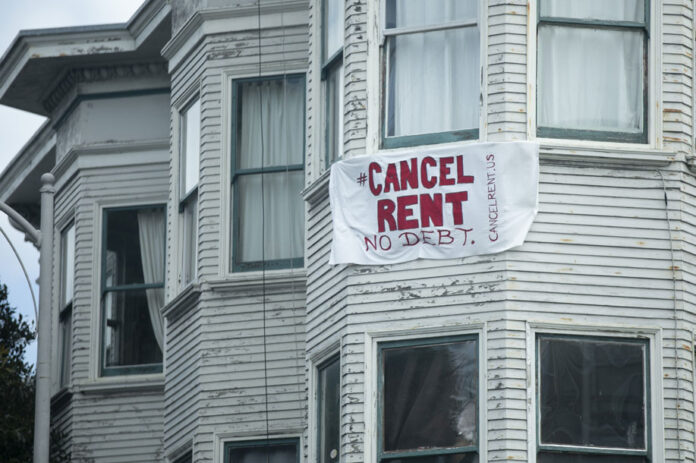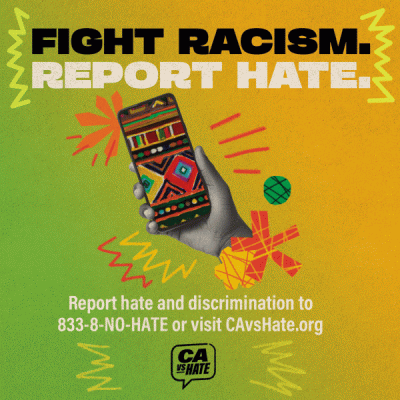
By Matt Levin, CalMatters
Every first of the month, California’s past due rent bill gets bigger.
As the state enters May sheltering in place for the seventh straight week to stop the spread of COVID-19, nearly 1 in 5 California workers have filed for unemployment, with millions more wondering if their next paycheck will actually materialize.
A disproportionate share of the abruptly laid-off and underemployed are lower-wage renters, who were already struggling to afford the state’s sky-high housing costs before the pandemic shuttered the restaurants, retail stores and rideshare operations that employed them.
As missed rent payments mount, California tenants and the landlords that depend on their monthly checks to pay their bills are increasingly and aggressively asking the same questions:
How much rent is going to be owed at the end of this? (A lot).
How long will tenants have to repay it? (Unclear).
Is the state going to pick up some of the tab? (Some, but the real help may have to come from the feds).
“Renters’ debt is going to chase people for years and years and years after this crisis is over,” said Shanti Singh, spokesperson for Tenants Together, one of a handful of renter groups that has called on state legislators and Gov. Gavin Newsom to forgive rent and mortgage payments while statewide emergency measures are in place.
“It’ll have lasting consequences for workers, for the economy, for homelessness that will reverberate way after coronavirus.”
While renters and landlords might disagree on the rules and mechanics of how the government should distribute rental aid, both groups are clamoring for a major infusion of public dollars.
California lawmakers are in the early stages of developing proposals to help, but how much the state can realistically afford is unclear as tax revenues shrivel and other pandemic-induced strains on the state budget mount.
“This is an unprecedented problem,” said Assemblyman David Chiu, Democrat from San Francisco, who has introduced several renter protection bills in his time in the state legislature. “And we’re not in a place yet where we know exactly how we can fix it.”
The looming renter crisis
Just how many California renters are behind on their payments?
No public data source exists that can reliably answer that question. Anecdotal reports and some limited industry data suggest April wasn’t as bad as some had anticipated. The National Multifamily Housing Council, which advocates on behalf of apartment owners, estimated over 90% of April rents nationally had been at least partially paid. In April of last year, the figure was 96%.
But landlords and tenants expect May to be considerably worse, as the ripple effects of the shutdown spread and renters run out of savings and other emergency resources they can tap.
“We don’t know how many tenants can make it another month, and then how many landlords can make it another month,” said Debra Carlton, executive vice president for state government affairs for the California Apartment Association.
UC Berkeley researchers estimate that more than 2.3 million California renter households have at least one worker in an industry that was immediately impacted by the shutdown orders; of those, roughly half met the federal definition of “rent burdened.”
GRAPHIC 1:
While expanded unemployment benefits and one-time stimulus funds approved by the federal government may take care of rent in cheaper parts of the country, those benefits aren’t adjusted for California’s high cost of living.
“The rent is going to eat up a lot of the (unemployment benefits),” said Elizabeth Kneebone, a researcher at the Terner Center for Housing Innovation at UC Berkeley. “If you’re getting unemployment in places like the Bay Area and Silicon Valley, it’s very possible most of it will be going to rent.”
So how much would California or the federal government have to spend to make up for missed rent payments?
Estimates vary widely, but the numbers are consistently large.
Kneebone’s research suggests that cumulatively, renters in industries immediately impacted by California’s shutdown owe $3.9 billion a month in rent. A study from the left-of-center Urban Institute suggested $100 billion might be necessary nationally if the aid was targeted exclusively to lower-income renters.
Can the state afford to help?
State Sen. Lena Gonzalez, Democrat from Long Beach, has introduced the first bill to provide some type of bailout funding for renters and landlords suffering from missed rent payments.
Sponsored by the landlord lobby, SB 1410 would have the state pay for 80% of missed rents for up to seven months if renters could demonstrate that they had been financially impacted by COVID-19. If landlords decided to accept payments from the state, they would give up pursuing the remaining 20% of missed rents and agree not to charge late fees or raise the rent for a year.
Conspicuously absent is a price tag, but bill backers say it could be in the ballpark of $2 billion.
“We have a bigger issue to worry about when it comes to homelessness and poverty that I think all contributes to this,” said Gonzalez, who cautioned that her staff was still in the process of researching an appropriate number and hoped the fund could draw down federal dollars as well. “So although it’s a huge ask, it really is encompassing all of these issues.”
GRAPHIC 2:
Carlton, the lobbyist for the California Apartment Association, said she hopes the state may be able to tap housing funds it had previously approved for homelessness or low-income housing development. One possible source: hundreds of millions from a new tax the state approved in 2017 on real estate recording documents, much of which was slated to go toward the construction of new housing.
Tenant groups so far have resisted backing Gonzalez’ proposal, although the senator cautions they are in the early stages of revising bill language and hope to see more renter groups get behind the bill.
Assemblyman Phil Ting, Democrat from San Francisco and chair of the Assembly budget committee, says that some type of general public assistance bond floated on the November ballot could potentially be used to fund additional rental help while buttressing state coffers. But he cautioned the lion’s share of the money would have to come from Washington D.C.
“It will have to primarily come from the federal government,” said Ting. “They have the ability to borrow money, and we don’t.”
Billions of dollars from the federal CARES Act headed to California could conceivably be redirected for rental assistance, although experts say more rounds of federal funding will be necessary to meet the need in any meaningful way. Given Senate Republican Majority Leader Mitch McConnell’s comments on allowing states to pursue bankruptcy in lieu of additional federal support, Ting says he’s unconvinced that funding will be forthcoming.
“I’m not confident the federal government can do anything at this point,” said Ting.
Ting has his own proposal for rental help that doesn’t require a major infusion of state dollars: AB 828 would allow renters facing the prospect of eviction for non-payment of rent to petition the court for a 25% reduction in rent payments for the next year, with the renter making up missed rent in monthly 10% installments. The rent reduction would only proceed if the court determined renters were unable to afford rent because of COVID-19, and small landlords would have an opportunity to demonstrate their own financial hardship resulting from reduced rents.
The landlord lobby, as well as developers and the California Chamber of Commerce, fiercely oppose Ting’s bill, arguing it unconstitutionally interferes with private contracts and forces landlords to swallow a rent reduction without any compensation.
Where renters and landlords agree, and where they don’t
While both landlords and renters agree emergency rental assistance is needed, they clash on what strings should be attached to the funds, especially when it comes to additional eviction protections.
Early last month, the state Judicial Council — which oversees California’s county court systems — suspended nearly all evictions in the state, except in cases with a threat to public health or safety. Courts across the state won’t allow evictions to proceed until 90 days after Newsom lifts the state of emergency, a date no one can predict with any certainty.
Renters who haven’t paid their April or May rents can still legally stay in their units for the time being. But eventually, as the state inches closer to a gradual re-opening, advocates are worried a flood of evictions are inevitable if the state doesn’t intervene.
“Right now we’ve hit pause, nobody can be physically evicted,” said Brian Augusta, legislative advocate for the California Rural Legal Assistance Foundation. “But those cases are still alive, they’re dormant and at some point they will spring to life. And if and when we take this off pause…we’re going to have a far worse affordable housing and homelessness crisis than where we were at the beginning of this.”
Tenants groups want that possibility off the table, arguing non-payment of rent during the pandemic shouldn’t be used as a reason for eviction once the emergency orders are lifted. They also insist that accepting rental assistance be mandatory, worrying landlords will simply decline state dollars so they can evict tenants they already view as problematic.
For example, a landlord could decline a state payment in order to evict a tenant in a rent controlled unit to raise the rent to market rates and easily recoup more than what they would have received from the government.
Rent forgiveness
California tenant groups organized a widespread rent strike May 1 calling for Newsom and state lawmakers to enact total rent forgiveness during the pandemic. The Alliance of Californians for Community Empowerment, a progressive renter advocacy group, estimated it was able to get 12,000 renters to participate.
While some local governments have extended the window in which renters can pay back missed rents — Los Angeles notably has granted renters a 12-month repayment period — no city has yet forced landlords to outright forgive all or some portion of missed rents.
“I think they know that would be challenged (in court),” said Carlton.
Forcing landlords to swallow large losses, especially smaller landlords, could be bad policy for California’s housing market long term, says David Garcia, a UC Berkeley housing researcher.
“At the point we start doing total rent forgiveness where property owners are assuming the total cost… it will chill investment in future properties,” said Garcia.
Who will ultimately bear the brunt of missed rent payments will depend significantly on Gov. Gavin Newsom, who so far has not weighed in forcefully in the debate.
Asked at his daily press conference how he felt about rent forgiveness, Newsom said, “Obviously with so many renters feeling deep anxiety and stress, we’re going to be very sensitive to that. But through May, I think we’ll have the next few weeks to really put together something if we do feel we need to do more.”
Newsom’s administration declined multiple requests for comment on this story.
The governor’s relationship with renter groups has frayed during the pandemic, as his early executive orders regarding eviction protections fell well short of what tenants had hoped for.
Newsom’s signature housing achievement to date came last year, when he helped usher through the Legislature a law that limits major rent hikes and forces landlords to provide a “just cause” for evictions.
“Newsom’s leadership was key to making that happen,” said Augusta, the tenant lobbyist. “And we need that leadership on this.”
CalMatters.org is a nonprofit, nonpartisan media venture explaining California policies and politics.



